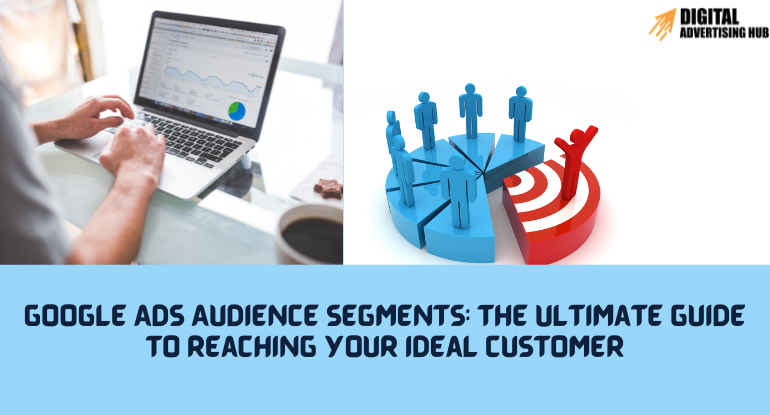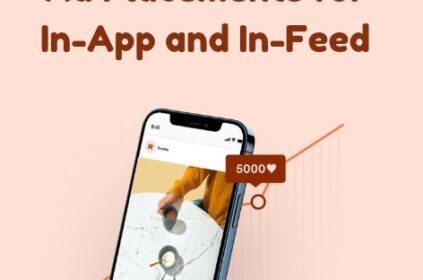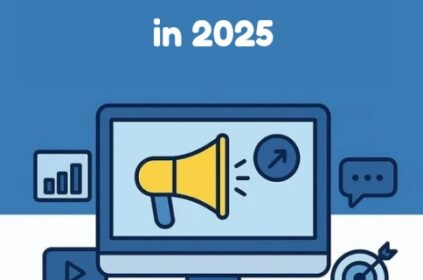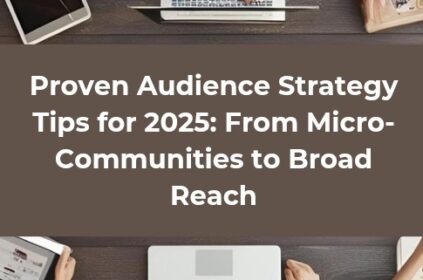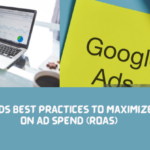Imagine reaching the perfect audience for your product or service with laser precision. No more bombarding everyone with your ads and hoping for the best. That’s the power of Google Ads Audience Segments.
In today’s digital marketing landscape, where attention spans are short and competition is fierce, targeting the right people is crucial for campaign success. While a scattershot approach might seem like a strategy, it often leads to wasted ad spend and minimal results.
Consider this: showing ads for high-end athletic wear to someone who prioritizes comfort over performance in their clothing is unlikely to convert. This is where Google Ads Audience Segments come in, offering a powerful solution to focus your campaigns and reach people who are genuinely interested in what you have to offer.
By leveraging audience segments, you can group potential customers based on specific characteristics like demographics, interests, online behavior, and even life milestones. This allows you to tailor your ad message to resonate directly with their needs and interests, significantly increasing the chances of them converting (taking a desired action, like making a purchase).
In this comprehensive blog post, we will dive deeper into the world of audience segments, explore the different types available, and learn how to leverage them to craft highly targeted campaigns that deliver exceptional results.
What are Google Ads Audience Segments?

Google Ads Audience Segments are like buckets that categorize potential customers based on specific characteristics. These characteristics can include:
1. Demographics: Age, gender, income, education, parental status, etc.
2. Interests: Long-term interests users have shown online, such as a passion for fitness or a love for travel.
3. Online Behavior: Past browsing activity, website visits, and app usage.
4. Life Events: Significant milestones users are going through, like getting married or graduating from college.
By leveraging this data, you can create highly targeted groups (segments) of users who share similar traits. This allows you to tailor your ad message to resonate directly with their needs and interests.
For instance, an athletic wear brand can create a segment targeting young adults with an interest in fitness who frequently visit sports apparel websites. This segment is much more likely to convert compared to a broad audience that includes everyone, regardless of their interest in athletic wear.
Why Use Audience Segments?
The benefits of using Google Ads Audience Segments are compelling and can significantly improve your campaign performance. Here’s a closer look at the advantages:
#1. Increased ROI (Return On Investment): By focusing on qualified leads who are genuinely interested in your product or service, you’ll see a better return on your ad spend. You’re essentially putting your money in front of the right people, maximizing the potential for conversions.
#2. Improved Conversion Rates: Since your ads are reaching a highly targeted audience, the chances of them converting (taking a desired action, like making a purchase) are significantly higher. You’re presenting your offering to users who are already primed for what you have, leading to a boost in conversions.
#3. Enhanced Brand Awareness: Targeted ads that resonate with the audience leave a stronger impression. This translates to better brand recognition and recall, ultimately strengthening your brand image in the minds of your target audience.
#4. Reduced Wasted Ad Spend: By eliminating irrelevant users from your targeting pool, you’re no longer spending money on impressions that are unlikely to convert. This allows you to optimize your budget and maximize its impact.
#5. Greater Campaign Flexibility: Audience segments offer a high degree of control over who sees your ads. You can create multiple segments for different campaign goals, allowing you to tailor your approach for maximum effectiveness.
#6. Deeper Customer Insights: Google ads audience segments provide valuable insights into your target audience’s behavior and preferences. By analyzing how different segments respond to your ads, you can gain a deeper understanding of your ideal customer and refine your marketing strategies for even greater success.
#7. More Personalized Marketing: With Google ads audience segments, you can craft personalized ad experiences that resonate on an individual level. This can lead to stronger customer engagement and loyalty.
#8. Improved Brand Credibility: Targeted ads that demonstrate an understanding of your audience’s needs and interests can position your brand as a trusted authority. This can lead to increased brand credibility and trust.
In conclusion, Google Ads Audience Segments offer a powerful and data-driven approach to target the right people with the right message at the right time. By leveraging audience segmentation, you can ditch the scattershot approach and take your Google Ads campaigns to the next level, achieving significant improvements in ROI, conversion rates, brand awareness, campaign efficiency, and customer insights.
Understanding the Power of Audience Segments: Targeting Made Easy
We’ve established that Google ads audience segments allow you to group users with similar characteristics. But how do these segments translate into real-world campaign benefits? Let’s explore some key types of segments and delve deeper into their functionalities:
#1. Demographics:
Imagine you’re a local bakery specializing in gluten-free and vegan treats. Demographics allow you to target users based on hard facts like age, household income, education level, parental status, and even location.
By utilizing demographics, you can tailor your ad message to resonate with specific age groups. For instance, targeting young adults with children might be more receptive to ads featuring allergy-friendly birthday cake options, while ads showcasing sugar-free pastries might resonate better with health-conscious adults with higher incomes.
#2. In-Market:
In-Market segments focus on users actively researching or considering a purchase. Google uses its vast search data to identify users exhibiting purchase intent for specific products or services.
In-Market segments allow you to target users who are already in the “consideration stage” of the buying journey. This is a powerful tool because you’re reaching users who are actively looking for solutions you provide.
For example, if you sell camping equipment, you can target users who have recently searched for keywords like “best tents for backpacking” or “camping essentials checklist”. These users are highly likely to be receptive to your ads showcasing top-rated tents or camping gear bundles.
#3. Affinity:
Affinity segments go beyond demographics to target users based on their long-term interests and passions. This allows you to reach users who are inherently more receptive to your brand message because their existing interests align with what you offer.
Affinity segments delve into a user’s online behavior to understand their passions and interests. This can include websites they frequent, apps they use, or YouTube channels they subscribe to. By leveraging Affinity segments, you can target users who are genuinely interested in your niche.
For instance, an organic clothing brand can create an Affinity segment targeting users interested in sustainable fashion blogs or eco-friendly product review websites. These users likely prioritize ethical consumption and eco-consciousness, making them a perfect audience for the organic clothing brand.
#4. Life Events:
Life Events segments capitalize on significant milestones users experience in life. This can be anything from getting married to graduating from college or becoming a new parent.
Life Events segments allow you to target users during crucial moments of change or transition. These users are often making purchasing decisions to accommodate their new life stages.
For example, an online learning platform can target a Life Events segment consisting of recent college graduates looking to upskill or pursue professional certifications. These individuals are likely seeking educational resources to advance their careers, making them a prime target for the online learning platform.
#5. Your Data Segments (Customer Match & Similar Audiences):
This category leverages your own customer data to reach existing customers or find new users similar to them. Customer Match allows you to upload your existing customer data (like email addresses) to create a segment. This lets you target existing customers with personalized ads for complementary products, special promotions, or loyalty programs.
Similar Audiences takes this a step further by using your customer data to find new users who share similar characteristics and buying behaviors with your existing customer base. This allows you to expand your reach and target a wider audience with a high likelihood of conversion.
By understanding these different types of Google ads audience segments and their functionalities, you can create highly targeted campaigns that resonate with your ideal audience. Remember, the more precise your targeting, the higher the chances of capturing user attention, driving conversions, and achieving your campaign goals.
Building Effective Audience Segments: A Step-by-Step Guide

Now that you’ve grasped the power of Google ads audience segments and their functionalities, let’s delve into the practical steps of using them effectively within your Google Ads campaigns. Here’s a detailed roadmap to help you craft highly targeted segments that drive results:
#1. Define Your Campaign Goals with Laser Focus:
The foundation of any successful campaign lies in clearly defined goals. What do you aim to achieve with your Google Ads efforts? Are you prioritizing increased brand awareness for a new product launch, generating qualified leads for your sales team, or driving online sales for your e-commerce store? Understanding your specific goals is crucial because it will guide your selection of Google ads audience segments.
Let’s consider two scenarios. Imagine you’re a company launching a new line of high-end athletic wear. If your primary goal is to generate brand awareness and introduce your brand to a wider audience, you might choose a broad demographic segment targeting young adults with a general interest in fitness.
This approach allows you to reach a large pool of potential customers and spark initial brand recognition. However, if your goal is to drive online sales for a specific product like performance running shoes, a more focused segment is necessary. Here, you might target young adults interested in running and marathon training. This segment is much more likely to be actively searching for running shoes and ready to convert, maximizing your return on ad spend.
#2. Craft a Detailed Profile of Your Ideal Customer: Empathy is Key
Before diving into building segments, take a step back and create a comprehensive profile of your ideal customer. This involves understanding them on a deeper level. Consider factors like:
1. Demographics: Age range, location, income level, education background, and even marital status can all play a role.
2. Interests: What are their passions and hobbies? What topics do they actively seek out online?
3. Online Behavior: What websites do they frequent? What apps do they use? What kind of content do they engage with online?
4. Life Stage: Are they students, young professionals, or parents? Understanding their current life situation can provide valuable insights into their purchasing behaviors.
Let’s revisit the organic clothing brand example. Their ideal customer might be a young professional between the ages of 25 and 35. This individual is likely environmentally conscious and prioritizes sustainable practices.
They might follow eco-friendly influencers on social media platforms like Instagram and actively visit websites promoting ethical consumption and sustainable fashion choices. By understanding these characteristics, the brand can build Google ads audience segments that resonate deeply with their ideal customer profile.
#3. Leverage the Power of Different Segment Types
Remember, there’s no magic formula when it comes to Google ads audience segments. The key lies in understanding the strengths of each type and strategically combining them to create highly targeted groups. Here’s a breakdown of how you can leverage different segment types:
1. Demographics: This provides a foundational layer for targeting based on basic characteristics.
2. In-Market: This allows you to reach users who are actively researching or considering a purchase related to your product or service.
3. Affinity: Go beyond demographics and target users based on their long-term interests and passions.
4. Life Events: Capitalize on significant milestones users experience in life to reach them during key purchasing decision points.
5. Customer Match & Similar Audiences: Utilize your existing customer data to target existing customers with personalized ads or reach new users with similar characteristics.
Building upon the organic clothing brand example, let’s explore how they can combine different segments. They can create a segment that combines Demographics (young professionals, aged 25-35) with Affinity (interested in sustainable fashion blogs).
This segment targets users within their ideal demographic who actively seek out information about sustainable fashion practices. Additionally, they can explore In-Market segments to target users who have recently searched for keywords like “organic clothing brands” or “eco-friendly clothing options”.
This captures users who are not only interested in sustainable fashion but are also actively looking to make a purchase. By combining these segments, the brand creates a highly targeted audience with a strong likelihood of converting.
#4. Continuous Refinement and Optimization: Embrace the Feedback Loop
Audience segmentation is an ongoing process, not a one-time setup. The beauty lies in its ability to adapt and improve based on real-world campaign data. Here’s how to optimize your segments for maximum impact:
#1. Monitor Campaign Performance: Closely track your campaign metrics to understand how different segments are responding to your ads. Analyze metrics like click-through rates, conversion rates, and cost-per-acquisition (CPA) for each segment.
#2. Analyze Segment Insights: Don’t just look at overall campaign data. Delve deeper and analyze how each individual segment is performing. This will reveal which segments are driving the most conversions and which ones might be underperforming.
#3. Refine Based on Data: Leverage the insights you gather to refine your segments. For instance, you might discover that a specific demographic within your segment (e.g., young professionals aged 22-24) has a lower conversion rate compared to the rest. You can then adjust the age range within your segment to exclude this underperforming group.
#4. Test and Experiment: Don’t be afraid to experiment with different segment combinations. The best approach is often discovered through testing and iterating. Try creating variations of your segments and see which ones yield the best results.
Continuing with the organic clothing brand, let’s say their analysis reveals that the segment targeting users interested in sustainable fashion blogs has a significantly higher conversion rate compared to the segment targeting users following eco-friendly influencers.
This data suggests that users who actively seek out information about sustainable fashion practices are more likely to convert than those who passively follow influencers. Based on this insight, the brand can optimize their campaign budget by allocating more resources towards the high-performing segment targeting blog readers.
Additionally, they can experiment with creating a new segment that combines users following eco-friendly influencers with an additional layer of targeting, such as In-Market users who have recently searched for “organic t-shirts”.
By following these steps and embracing a data-driven approach to audience segmentation, you can continuously refine your segments, optimize your campaigns for maximum impact, and ultimately achieve your marketing goals. Remember, the more precisely you target your ads, the greater the chance of capturing user attention, driving conversions, and propelling your Google Ads campaigns to new heights.
7 Common Errors to Avoid in Google Ads Audience Segments for Higher ROI
While audience segmentation offers immense potential for campaign success, navigating its functionalities can lead to pitfalls. Making mistakes when building your Google ads audience segments can result in wasted ad spend, underwhelming click-through rates, and ultimately, a lower return on your investment (ROI).
Here, we’ll explore seven common errors to steer clear of and ensure your Google ads audience segments are driving optimal results.
Error #1: Targeting Too Broadly:
Casting a wide net might seem like a safe bet, but it often leads to missed opportunities. Imagine showing ads for high-end running shoes to everyone who has ever expressed an interest in fitness.
A significant portion of this broad audience might be casual walkers or gym enthusiasts with no intention of buying running shoes. This results in wasted ad spend and minimal conversions.
Instead of a broad “fitness enthusiast” segment, create a more targeted segment combining Demographics (young adults, aged 25-35) with Affinity (interested in running websites or blogs).
Additionally, consider layering in In-Market segments targeting users who have recently searched for keywords like “running shoes for beginners” or “marathon training tips”.
Error #2: Targeting Too Narrowly:
While narrow segments can be laser-focused, they can also restrict your reach and limit potential conversions. For instance, targeting only marathon runners within your running shoe segment might exclude a larger pool of potential customers who are serious runners but haven’t participated in a marathon yet.
To avoid the error, balance precision with reach. Consider broadening your segment slightly to include users interested in running magazines or apps alongside marathon runners. This expands your target audience while maintaining a focus on serious runners.
Error #3: Ignoring Negative Audiences:
Negative audiences allow you to exclude users who are unlikely to convert, further refining your targeting. Not utilizing negative audiences can lead to showing your ads to users who have zero interest in what you offer, again impacting your ROI.
For example, the running shoe brand can create a negative audience to exclude users who have recently searched for keywords like “walking shoes” or “ballet shoes”.
In order to avoid this error, you should regularly review your search term reports within Google Ads to identify irrelevant keywords triggering your ads. Add these keywords to your negative audience list to prevent future wasted impressions.
Error #4: Neglecting Customer Data:
A treasure trove of valuable information lies within your existing customer data. Failing to leverage this data for audience building means missing out on the opportunity to target users with similar characteristics and buying behaviors to your best customers.
To avoid the mistake, upload your customer email list to create a Customer Match audience. This allows you to target existing customers with personalized ads for complementary products or special promotions. Additionally, utilize Similar Audiences to reach new users who share similar demographics and interests with your existing customer base.
Error #5: Failing to Monitor Performance:
Building segments is just the first step. Tracking their performance and analyzing how different segments respond to your ads is crucial. Not monitoring performance can leave you blind to underperforming segments that might be dragging down your overall campaign results.
To avoid the error successfully, set up conversion tracking within Google Ads to measure key actions users take on your website or landing page after clicking your ad (e.g., purchases, sign-ups).
Regularly review your segment reports and analyze metrics like click-through rate, conversion rate, and cost-per-acquisition (CPA) for each segment. Identify and optimize underperforming segments by adjusting targeting parameters or allocating budget towards high-performing segments.
Error #6: Setting Unrealistic Conversion Goals:

It’s important to set achievable conversion goals for different segments. Expecting the same conversion rate from a broad segment targeting young adults interested in fitness compared to a narrow segment targeting marathon runners is unrealistic.
Tailoring conversion goals based on segment characteristics allows for a more accurate assessment of campaign effectiveness.
To avoid this error, consider the intent level within each segment when setting conversion goals. A broad segment might have a lower conversion goal for initial purchases but a higher goal for adding products to cart. A narrow segment targeting users with high purchase intent (e.g., marathon runners) can have a higher conversion goal for completing a purchase.
Error #7: Not Testing and Experimenting:
The best approach to audience segmentation is often discovered through experimentation. Don’t be afraid to test different combinations of segments, demographics, and interests. Analyze the results and refine your segments based on what resonates most with your target audience.
To avoid this mistake, create variations of your ad groups targeting different audience segments. Run A/B tests to see which segment combinations yield the best results. Continuously experiment and refine your targeting strategy based on data- driven insights to maximize your campaign performance.
By avoiding these common pitfalls and adopting a data-driven approach, you can ensure your audience segments are laser-focused and deliver exceptional results.
Remember, effective audience segmentation is the key to unlocking the full potential of your Google Ads campaigns, leading to a significant boost in ROI, brand awareness, and ultimately, achieving your marketing goals. So, take control, leverage the power of audience segments, and watch your campaigns soar!
Conclusion
In conclusion, reaching the right audience is no longer a guessing game. Google Ads Audience Segments empower you to wield the power of data and target your ideal customers with laser precision. By leveraging demographics, interests, online behavior, life stages, and even your own customer data, you can create highly targeted segments that resonate deeply with your audience.
This guide has equipped you with the knowledge and steps to build effective audience segments. It is worthy to note that the key lies in understanding your campaign goals, crafting a detailed profile of your ideal customer, and strategically combining different segment types.
Embrace the ongoing process of refinement and optimization by closely monitoring campaign performance and leveraging data insights to continuously improve your segments.
By mastering the art of audience segmentation, you can unlock a world of possibilities for your Google Ads campaigns. Imagine achieving:
1. Soaring ROI: Eliminate wasted ad spend by targeting only users who are genuinely interested in what you offer.
2. Skyrocketing Conversion Rates: Reach users who are already primed to convert, leading to a significant boost in sales or leads.
3. Enhanced Brand Awareness: Craft targeted ads that resonate with your audience, leaving a lasting impression and strengthening your brand image.
5. Deeper Customer Understanding: Gain valuable insights into your target audience’s behavior and preferences, allowing you to refine your marketing strategies for even greater success.
So, take the first step today. Embrace the power of audience segmentation and watch your Google Ads campaigns soar to new heights! Take your learning further by studying our guide, “Audience Segmentation on Instagram for Instagram Ads“.

